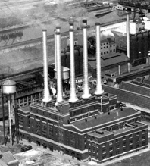
Environment and the Automobile in American Life and Society
When we think of the automobile’s impact on the environment, the first thing we envision is likely to be exhaust fumes pouring from a tailpipe. But when cars were first introduced into American cities in significant numbers, they were seen as the solution to a pollution problem—horses. Historian Clay McShane has estimated that during the latter part of the nineteenth century the horses in New York City dropped 800,000 to 1.3 million pounds of manure every day, much of it on the streets. With the addition of all the urine, and the corpses of animals that dropped dead from disease or exhaustion and were often left where they fell, crowded city streets were dirty, foul-smelling, and fly-ridden, especially in hot weather. It’s easy to see why many urbanites hailed the coming of “horseless carriages.”
Martin Melosi examines this history of the automobile’s environmental impact in greater detail in his overview essay before taking up the car’s influence on our “environment” in a broader sense: the layout, physical geography, and design of our communities, our cities and suburbs. He traces the car’s role in the transformation and decline of many urban centers and in the simultaneous development and rise of suburbs. Traffic, road systems, traffic lights, parking lots, gas stations, car washes, fast food restaurants, billboards, malls, superstores, subdivisions—so many of the elements of our lives and worlds are the result of the automobile.
About the Project | Credits | Contact Us | Student & Teacher Resources
©2004-2010 Automobile in American Life and Society
